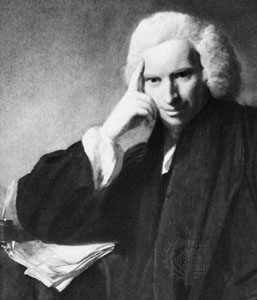A FEW GENERAL REMARKS
From the publication of the first two volumes, Tristram
Shandy was a success, and a success not only in England but also in
France, Italy, and Germany.  The
characters of Uncle Toby and Corporal Trim and the Widow Wadman episode
were particularly admired, and Sterne's humor was generally
appreciated. Sterne regarded humor as "the gift of God," and he used it
to achieve satiric ends. He
acknowledged following Cervantes's lead in "describing silly and
trifling Events, with the Circumstantial Pomp of Great Ones." Writing a
comic novel with serious goals presented difficulties for Sterne, "I am
going down to write a world of Nonsense–if possible like a man of Sense–but
there is the Rub." The "rub" or the potential incompatibility
which Sterne anticipated may apply to the reader as well. Do we read
seriously, looking for meaning(s) and enjoying the humor as we go, or
do we read as game players, having fun and taking serious meanings as
they reveal themselves? or is there some other way to read this novel?
Is Ian Watt right that "through imaginative play we learn about
ourselves"? The
characters of Uncle Toby and Corporal Trim and the Widow Wadman episode
were particularly admired, and Sterne's humor was generally
appreciated. Sterne regarded humor as "the gift of God," and he used it
to achieve satiric ends. He
acknowledged following Cervantes's lead in "describing silly and
trifling Events, with the Circumstantial Pomp of Great Ones." Writing a
comic novel with serious goals presented difficulties for Sterne, "I am
going down to write a world of Nonsense–if possible like a man of Sense–but
there is the Rub." The "rub" or the potential incompatibility
which Sterne anticipated may apply to the reader as well. Do we read
seriously, looking for meaning(s) and enjoying the humor as we go, or
do we read as game players, having fun and taking serious meanings as
they reveal themselves? or is there some other way to read this novel?
Is Ian Watt right that "through imaginative play we learn about
ourselves"?
One of Sterne's goals in writing Tristram Shandy
"was the hopes of doing the world good by ridiculing what I thought
deserving of it–or of disservice to sound learning." Sterne's satire of
faulty scientific reasoning or misuse of knowledge is, I suspect, the
part of the novel that is most difficult for most of us to understand.
If this is the case, I suggest that, as you read passages which are
laden with footnotes explaining Sterne's allusions, you keep in mind
his purpose, even if you don't understand all the details or follow his
argument completely. For example, Sterne explained that in his chapter
on noses, "the principal satire throughout that part is levelled at
those learned blockheads who, in all ages, have wasted their time and
much learning upon points as foolish"; in other words, their learned
theories are as ridiculous as Mr. Shandy's theories about noses.
The greatest objections which Sterne's contemporaries
had to the novel stemmed from his sexual references and innuendos,
which, coming from a clergyman, shocked many. Samuel Richardson wrote
that Sterne's "character as a clergyman seems much impeached by
printing such gross and vulgar tales, as no decent mind can endure
without extreme disgust!" It is a criticism that has continued. Sir
Walter Scott, writing half a century later, voiced the same basic
objection, though more temperately,
... it cannot be said that the licentious
humour of Tristram Shandy is of the kind which applies itself
to the passions, or is calculated to corrupt society. But it is a sin
against taste, if allowed to be harmless as to morals. A handful of mud
is neither a firebrand nor a stone; but to fling it about in sport,
argues coarseness of mind, and want of common manners.
For Scott, however, the delightful Uncle Toby and Trim more than
compensated for Sterne's faulty practices, including his "indecorum."
STERNE: A MODERN NOVELIST?
Sterne has been called a modern novelist because of his
novelistic practices and themes:
- He is concerned with the nature
of time and plays with its various forms, e.g., chronological time,
the reader's time.
- He uses the
association of ideas to portray how his characters' (and our) minds
work and to organize his novel.
- He challenges the conventions of the novel, e.g.,
chronological development and the use of dedications and prefaces, and
explores the relationship between reality and the illusion of fiction.
- He upsets the reader's comfortable expectations and
unthinking assumptions.
- He makes the reader part of the process of writing a
novel by sharing creative decisions as Tristram writes the novel.
- He presents the essential aloneness of human beings,
with each of his characters being the center of his own world.
- He shows the chaotic nature of life by presenting effects or consequences before their
causes, by showing trivial causes having momentous consequences, and by
showing momentous causes having trivial consequences.
- He reveals the unreliable nature of language and
verbal communication.
- As a result of the above, reality and character
become fluid, i.e., are constantly changing, and thus unpredictable;
and the truth becomes difficult, if not impossible, to determine.
In considering whether Tristram Shandy is a modern novel
in any way, you might compare Tristram Shandy to the
other eighteenth century novels you have read and/or novels which you
consider modern.
STERNE SYLLABUS
October 13, 2004
|

